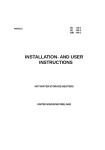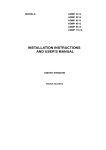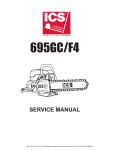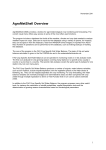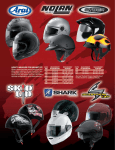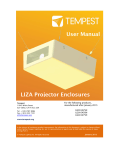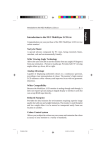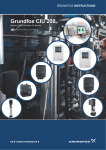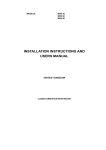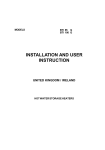Download A.O. Smith EQ 380 G Installation and Use Manual
Transcript
MODELS EQ 280 G EQ 380 G INSTALLATION- AND USER INSTRUCTION UNITED KINGDOM / IRELAND WATERSTORAGE HEATERS Read these installation instructions first before installing the appliance. Carefully read the user instructions before igniting the appliance. Failure to follow these instructions may lead to risk of explosion and/or fire and could cause material damage and/or bodily harm. Installation and commissioning should be carried out by a qualified competent installer. The type of gas and the value at which the appliance is set standard in the factory are registered on the rating plate. The appliance may only be installed in a room if this room meets the ventilation requirements. A.O. SMITH ACCEPTS NO RESPONSIBILITY FOR WARRANTY, SERVICE AND/OR PRODUCT LIABILITY IN CASE OF UNAUTHORIZED ALTERATIONS, PRODUCT MODIFICATIONS OR REPAIR. 2 CONTENTS PAGE 1. General. ......................................................................................................... 4 1.1 1.2 1.3 1.3.1 1.3.2 - 2. For the installer. ......................................................................................... 12 2.1 2.1.1 2.1.2 2.1.3 2.1.4 2.1.5 2.2 2.3 2.4 2.5 2.6 2.7 2.8 2.8.1 2.8.2 2.8.3 2.8.4 2.9 2.10 2.11 2.12 2.13 - 3. For the user. ............................................................................................... 22 3.1 3.2 3.3 3.4 - 4. Guarantee. .................................................................................................. 24 Description of the appliance .......................................................................... 4 Technical safety equipment ........................................................................... 6 Technical description ..................................................................................... 8 Dimensions .................................................................................................... 8 Technical data ............................................................................................. 10 Installation instructions ................................................................................ Installation .................................................................................................... Water connection ........................................................................................ Gas connection ........................................................................................... Flue system ................................................................................................. Flue down draught safety device ................................................................ Commissioning ............................................................................................. Pilot adjustment ............................................................................................ Putting out of operation ................................................................................ Temperature regulation ................................................................................ Setting the nominal heat input ...................................................................... Conversion procedure ................................................................................. Maintenance ................................................................................................ Sacrificial anode .......................................................................................... Cleaning ....................................................................................................... Decalcification ............................................................................................. Spare parts .................................................................................................. Inlet combination .......................................................................................... Fault finding ................................................................................................. Gas smell ..................................................................................................... Condensation ............................................................................................... Important warning ........................................................................................ Commissioning ............................................................................................. Use .............................................................................................................. Putting out of operation ................................................................................ Fault finding ................................................................................................. 12 12 12 13 14 14 15 16 16 16 17 17 19 19 19 20 20 20 20 21 21 21 22 22 22 23 3 1. GENERAL 1.1 Description of the appliance Construction of the water heater is in accordance with the European standard for gas heated water storage heaters for sanitary application (EN 89). The appliance thus meets the European Directory for Gas Appliances and is therefore entitled to carry the CEmarking. It is an open flued appliance without ventilator and with a flue gas down draught safeguard (category B11BS). The water heater is suitable for a maximum working pressure of 8 bar. The water-heater tank is manufactured from low carbon sheet steel and is glass-lined on the inside. In addition the tank is fitted with a sacrificial anode as an extra protection against corrosion. A thick PU-insulation layer covered in a steel jacket reduces unnecessary heat loss. When the appliance is filled with water it continuously is under water pressure. As hot water is drained from the tank, cold water is added immediately. Four flue baffles has been placed in the flue tube to improve heat transfer. The flue gasses pass their heat on to the water by means of radiation and convection. The flue gasses are guided to the chimney via the draught diverter. The exhaust of the flue gasses is realized by natural thermal draught (see drawing 1). Dead legs on a hot water installation are undesireable. Where possible they should be avoided. Where the inclusion on the system of a dead leg is unavoidable the following restrictions should be applied: - for pipes not exceeding 19 mm. inside diameter; maximum lengh of dead leg permitted 12.0 metres; - for pipes exceeding 19 mm. but not exceeding 25 mm. inside diameter; maximum length of dead leg 7.5 metres; - for pipes with an inside diameter 4 exceeding 25 mm. maximum dead leg 3.0 metres. Drawing 1 - Cross-section of the appliance 1) 2) 3) 4) 5) 6) 7) Draught diverter Hot water outlet Insulation material Flue tube Glass lined tank Gas control valve Cold water inlet pipe 8) 9) 10) 11) 12) 13) 14) T&P safety connection Steel jacket Flue baffle Sacrificial anode Drain tap Atmospheric burner Pilot light burner with thermocouple 5 1.2 Technical safety equipment Gas control block The water heater has been fitted with a gas control block consisting of a thermo-electrical pilot flame safeguard, pilot flame pressure regulator, burner pressure regulator, a control thermostat (adjustable between 30°C and 71°C) and a safety thermostat (82°C). This gas control block with its simple and secure control respectively switches the gas supply to the main burner on or off. This gas control block is suitable for gasses from the first, second and third gas family. The maximum inlet pressure is 50 mbar. Drawing 2 - Gas control block with T.R.S. 6 Thermal Reflux Safeguard The heater is fitted with a flue gas blowback safety device. The functioning of the safety device is based upon the principle of the Thermal Reflux Safeguard – TRS for short – shown in Fig.2. This TRS can be recognized by the copper coloured spiral that is fitted to the lower edge of the draught diverter. The spiral is connected to a thermostat by means of a capillary tube. The wiring of the thermostat must be connected to the thermocouple circuit. 1) T.R.S. thermostat 2) Sensor T.R.S. thermostat 3) Thermocouple with built-in interrupter 4) Thermocouple 5) Gas control block 6) Reset button 7) Pilot burner 8) Temperature regulator knob It is the aim of the T.R.S. to prevent flue gasses from the water heater entering the room where the water heater has been placed, instead of passing through the flue to outside atmosphere. The thermo-couple circuit is interrupted and the gas supply is disconnected as soon as the T.R.S. is activated by heating of the sensor by the hot gasses. After the cause of the reentry of flue gasses has been traced the device can be put back into operation again. In case of T.R.S. the RESET button has to be pressed first. If this failure occurs frequently, this indicates that the flue suffers from down draught conditions. We advice that necessary remedial actions be carried out by a competent person. Important If the water heater is put out of operation by a failure, this may be caused by the T.R.S.. If there is a RESET button on the thermostat this is visible because the button rose. The device can be put back into operation by pressing the RESET-button. The T.R.S. should never be put out of operation. Reentry of flue gasses to the building could be harmful and cause poisoning or death. Attention: Instruction addition for installer. Fitting the Thermal Reflux Safeguard: 1. Remove the two screws from the lid; 2. Position the support (with preassembled TRS) onto the lid; 3. Secure the support, using both screws; 4. Interconnect the male and female connectors on the lid. 7 1.3 Technical description 1.3.1 Dimensions These water heaters are only suitable for a flue tube with minimal the announced diameter (dimension G). Dim. EQ 280 EQ 380 A 1585 1780 B 1450 1640 D 645 675 F 730 765 G K 130 390 130 390 (zie fig.3) L 375 385 M 1505 1685 N 1505 1685 R 285 275 S V 1280 410 1460 410 1 Cold water inlet 2 Warm water outlet 3 Gas control block 4 Drain tap 5 T&P relief valve tapping All dimensions are given in mm. (rounded off on 5 mm). 8 Drawing 3 - Dimensions 9 1.3.2 Technical data Device category: II2H3+ DESCRIPTION unit EQ 280 EQ 380 DATA NATURAL GAS G20 - 20 mbar: Nominal heat input (lower value) kW 22.6 24.0 Nominal power kW 19.2 20.4 Inlet-pressure (G20) mbar 20 20 Burner pressure (G20) mbar 12.5 8.7 Gas consumption (G20) * m3/h 2.4 2.5 Diameter main orifice (G20) mm 3.90 4.50 Diameter pilot orifice (G20) mm 2 X 0,27 2 X 0,27 Warming-up time ∆T= 45 K min. 56 61 Nominal heat input (lower value) kW 22.6 24.0 Nominal power kW - - Inlet-pressure (G30) mbar 30 30 Burner pressure (G30) mbar 30 30 Gas consumption (G30) * kg/h 1.8 1.9 Diameter main orifice (G30) mm 2.30 2.35 Diameter pilot orifice (G30) mm 2 x 0.16 2 x 0.16 Warming-up time ∆T= 45 K min. - - Nominal heat input (lower value) kW 21.1 22.9 Nominal power kW - - Inlet-pressure (G31) mbar 37 37 Burner pressure (G31) mbar 37 37 Gas consumption (G31) * kg/h 1.6 1.8 DATA BUTANE G30 - 30 mbar: DATA PROPANE G31 - 37 mbar Diameter main orifice (G31) mm 2.25 2.35 Diameter pilot orifice (G31) mm 2 x 0.16 2 x 0.16 Warming-up time ∆T= 45 K min. - - 10 DESCRIPTION unit EQ 280 EQ 380 GENERAL Storage capacity litres 265 355 Water connections ** - 1" - 14 NPT 11/4" - 14 NPT Gas connection - ISO 7/1 Rp 1/2 ISO 7/1 Rp 1/2 Drain tap - 3 3 Anode - 3 3 - 3 3 T&P-plug /4" - 14 NPT /4" - 14 NPT /4" - 14 NPT /4" - 14 NPT /4" - 14 NPT /4" - 14 NPT Maximum working pressure bar 8 8 Empty weight kg 153 178 * Gas consumption at 1013,25 mbar and 15°C ** For a leak-proof sealed connection European coupling pieces can be used on the NPT-connection nipples with a pipe thread of ISO 228/1 11 2. FOR THE INSTALLER 6644, 6700, 6798 and 6891. 2.1 Some chemicals produce vapours which can cause rapid failure of thermocouples, burners and storage tanks if they are drawn into the combustion air supply. Therefore if this water heater will be used to supply hot water to: - hairdressers, - dry cleaners - industrial degreasing processes or any other area where compounds containing halogens are used and stored, care should be taken that all primary and secondary air is drawn from outside atmosphere free of such contaminents. For further advise contact A.O. SMITH. Installation instructions This water heater must be fitted in a location which will permit the provision of an approved flue system and adequate ventilation. A service clearance of 15 cm at the sides and rear of the unit and 60 cm at the front of the unit should be allowed for ease of servicing. Adequate distance must be allowed between the top of the unit and any obstruction or ceiling to allow the flue baffle and anode to be inspected, cleaned or in the case of the anode replaced if necessary. The water heater must stand on a level surface resistant to heat and with sufficient strength to support the weight of the unit when full of water. This water heater must not be installed in a bath room, bedroom or in a cupboard opening on to such rooms. This water heater must not be installed in any area where flamable materials are used or stored. Insufficient ventilation may give rise to a risk of fire, explosion or suffocation. If in doubt consult the national and local regulations governing the installation of gas appliances or your local British gas service department. 2.1.1 Installation The installation of this water heater should be carried out by a suitably qualified competent person. It is a criminal offence for unqualified persons to install gas equipment. Installation should be carried out in accordance with all local authority and building regulations, local water authority and fire regulations and the following British standards: 5440, 5546, 12 2.1.2 Water connections A.O. Smith water heaters are suitable for connection to vented, unvented and pumped pressurised systems. In each case appropriate valves and fittings should be used to ensure the system complies with the requirements of the water by laws, and appropriate building regulations. When fitting it is essential the rules of 'good practice' are applied at all stages of installation. Vented systems If the water heater is to be connected to a cold feed tank or cistern the hot water supply pipe must include an open vent which discharges over the cold feed cistern. The cold feed cistern must have an actual capacity of greater volume than the hourly recovery rate of the water heater(s) which it supplies.The minimum actual capacity is 50 gallons or 227 litres. Unvented To install an A.O. Smith water heater on an unvented cold water supply system a kit of valves and fittings listed by the water research centre and complying with part G3 of Drawing 4 - Connection diagram (unvented system) 1) 2) 3) 4) 5) 6) 7) Gas cock Stop valve Expansion vessel T&P safety valve Non return valve Circulation pump Drain valve the current building regulations should be used. Installation should be carried out generally as shown on the following diagram. See drawing 4. A.O. Smith water heaters are tested to a maximum pressure of 12 bar and a maximum working pressure of 8 bar. 8) 9) A) B) C) D) E) Pressure limiting valve Pressure relief valve Gas supply Hot water outlet Cold water inlet Hot wayer outlets Return circulation loop 2.1.3 Gas connection The gas supply to this appliance must be installed in accordance with BS 6891 (1988). Fit the 1/2" gas supply cock supplied with this unit immediately before the gas control block. No heat or soldered joints should be applied in the vicinity of the gas control block, as they could cause damage to the control. 13 All connections and joints should be tested for gas soundness with a suitable leak detector (do not use a naked flame). 2.1.4. Flue system The water heater should be fitted with a flue system connected to the draught diverter. The flue pipe should rise for at least 50 cm. vertically before the inclusion of any bends. If a horizontal run of flue is required this should be kept to the minimum length possible and incorporate a rise of 6 cm. per metre of run. A split clip or flange should be provided in the flue close to the draught diverter for ease of servicing. All flue materials should be corrosion resistant i.e. stainless steel or galvanised and must include a tested and approved terminal to BS 5440 part I. If the flue passes through any combustible material measures must be taken to protect against the possibility of fire. All flues must terminate in free air space approx. 1.5 metres from any vertical surface of structure i.e. chimney stacks, roof parapets, etc. If an existing chimney or flue is to be used this should be swept clean and be free of debris before an approved liner is installed and connected to the water heater. 2.1.5 Draught diverter The draught diverted is fitted with a temperature sensor to signal the blowback of flue gases. Important The T.R.S. should never be put out of operation. The reentry of flue gasses may cause poisoning. 14 2.2 Commissioning Filling the water heater 1. Close the drain tap. 2. Open the cold water tap to the water heater and open all taps where hot water can be drained for deaeration. The water heater is filled as soon as cold water flows from all taps. 3. Close all hot water taps. Putting into operation 1. Check whether the water-heater has been filled with water and whether the gas supply to the water heater is open. 2. Turn the temperature control knob clockwise and place the control knob in the ‘PILOT’-position (✸). 3. Remove the outer door of the combustion chamber. 4. Keep the control knob pushed-in and press the piezo-ignitor several times until the pilot burns (see drawing 6). 5. Keep the control button (✸) pushedin for approximately 20 seconds. After releasing the button the pilot should remain burning. If the pilot extinguishes you should wait 5 minutes before repeating the ignition procedure. The size of the pilot flame can be adjusted (see also “Pilot adjustment”). 6. Fit the outer door; 7. Turn the control button to the ‘ON’ ( ) position. 8. Check the burner pressure setting (see drawing 9) and, if necessary, adjust this in accordance with the technical data (see page 10). 9. Place the temperature control button in the correct position, preferably position 4 (approximately 60°C). The appliance will now operate fully automatically. Drawing 6 - Operation of the gas control block 15 2.3 Pilot adjustment The pilot can be adjusted by means of the regulating screw under the plastic cover on the right hand side of the gas control block. Turn the screw clockwise to reduce the gas pressure and anti clockwise to increase the pressure. Care should be taken to ensure the pilot covers the thermocouple element correctly. 2.4 Putting out of operation 1. For short periods of time the control knob should be turned to (✸); the pilot keeps burning. 2. For longer periods of time the knob should be turned to the (●) position; the pilot is extinguished. 3. Close the gas tap in the supply pipe. In case of longer interruptions or in the event of risk of frost it is recommended to also close the cold water tap and to drain the appliance after cooling (open the drain tap; it is possible to connect a drain hose to the drain tap; open the nearest hot water drain point to prevent air locks). To be able to drain the appliance completely it should be disconnected and tilted slightly in the direction of the drain tap. 2.5 Temperature regulation The appliance is under water supply pressure (maximum 8 bar). The amount of cold water that is added is equal to the amount of hot water used. The gas control block automatically regulates the gas supply. The main burner will ignite as soon as a reduction in water temperature is sensed by the thermostat. The main burner will shut down as soon as the preset temperature is achieved. Position 1 = approximately 30°C Position 2 = approximately 40°C Position 3 = approximately 50°C Position 4 = approximately 60°C Position 5 = approximately 70°C At high water temperatures there is more scale buildup in the appliance. It is for this reason that it is recommended to place the temperature control knob in position 4 as the accumulation of scale will be reduced. In addition a safety thermostat has been fitted. This thermostat completely shuts off the gas supply if the water temperature reaches 82°C, also extinguishing the pilot burner. Drawing 8 - Setting the pilot 16 2.6 Setting the nominal heat input The gas control has been factory preset to the water heater nominal heat input. A further check of the burner pressure should be carried out during the commissioning of the unit after installation. The following procedure should be followed. 1. Remove the protruding cover screw on the right side of the gas control block and connect a U-gauge manometer to the outlet. 2. Put the appliance into operation and ignite the burner. 3. Check the burner pressure and, if necessary, reset by means of the adjusting screw “pr adj” (pressure adjustment; see drawing 9). To make this possible the temperature control knob should be removed by pulling it straight forward, making the “pr adj” visible. Turning clockwise reduces the pressure; turning anti clockwise increases the pressure. It is recommended to check the heat input by means of the gas meter. 4. Turn off the appliance and remove the manometer hose and replace the adjusting screw. 5. Relace the thermostat control knob. 6. Put the appliance into operation. 2.7 Converting to another type of gas For conversion of the appliance from natural gas to another type of gas, or vice versa, it is necessary to exchange the pilot injector and the main injector. The conversion may only be executed by a qualified competent person. Drawing 9 - Setting the nominal load 17 EQ 280 Unit EQ 380 G20 G30 G31 G20 G30 G31 Inletpressure mbar 20 30 37 20 30 37 Burner pressure mbar 12.5 30 37 8.7 30 37 mm 3.90 2.30 2.25 4.50 2.35 2.35 mm 2x 0.27 2x 0.16 2x 0.16 2x 0.27 2x 0.16 2x 0.16 Diameter main injector Diameter pilot injector Procedure: 1. Close the main gas tap in the gas supply. 2. Demount the burner (see “Cleaning”). 3. Replace the injector of the main burner and the pilot burner with the correct injectors from the conversion set (see table above). Conversion from natural gas to LPgas: - Put the pressure regulation of the gas control block out of operation. To do this the temperature regulating knob should be pulled straight forward. Turn the ‘no pr’ (no pressure regulation) screw down tight (see drawing 10). - Seal this setting with lacquer. - Remount the burner in reverse order. - Open the main gas tap. 18 Conversion from LP-gas to natural gas: - Put the pressure regulator into operation. To do this the temperature regulating knob should be pulled straight forward. Next the red plastic cover that is now visible, should be removed. Turn the ‘no pr’ (no pressure regulation) screw completely up (see drawing 10). - Seal this setting with lacquer. - Remount the burner in reverse order. - Open the main gas tap. - Set the correct burner pressure (see table above). 5. If necessary adjust the pilot correctly (see “Pilot adjustment”). 6. Fit the correct sticker from the conversion set on the appliance so that it is clear that the appliance has been converted and on which gas the appliance operates. Drawing 10 - Conversion to another gas 2.8 Maintenance To ensure safe and efficient operation of the water heater it is recommended that it is cleaned and serviced at least once a year by a qualified competent person. 2.8.1 Sacrificial anode The life cycle of the anode is determined by the quality and the quantity of the water flowing through the apparatus. It is therefore recommended that the anode be inspected and replaced if necessary at least once a year. 1. Close the stop cock in the cold water supply pipe. 2. Open the nearest hot water tap in order to allow the pressure to drop from the water heater and the pipes. 3. Slacken the anode with a fitting wrench. 4. Check the anode and replace it if it has been reduced in diameter by 60% or more at any point on its length. 5. Check for water leaks. If it is necessary to replace the anode it should always be replaced by one of the same type. The type of anode required can be determined on the basis of the type of the appliance and the serial number. 2.8.2 Cleaning 1. Close the gas supply and demount the burner after it has cooled down; 2. Disconnect the burner, pilot pipe and thermo couple from the gas control block (see drawing 11); 3. Remove the complete burner assembly; 4. Clean the burner with a soft brush; 5. Check the pilot burner and clean it if so required; 6. Check the combustion chamber, flue tube and flue baffle and clean these if required; 7. Re-mount in reverse order. Tighten the thermo couple connection on the gas control block hand tight and tighten it further with a wrench to a maximum of 1/4 turn as it only needs to make contact. After cleaning of the pilot- and main burner the operation of these should be checked. If necessary the burner pressure of the main burner should be reset. 19 2.8.3 Decalcification Formation of lime scale depends on the quality and quantity of the water used. In addition higher water temperatures lead to more deposit in the appliance. A temperature setting of 60°C is recommended in order to keep the calcification at a low level. Decalcification should be attempted with the proper means. For extensive information a decalcification instruction is available. 2.8.4 Spare parts To be able to order spare parts it is important to note the type of appliance as well as the serial number of the appliance. Based on this information the data concerning the spare parts can be determined. 2.9 Inlet combination Not applicable in U.K. and Ireland. 2.10 Fault finding In case of failure the following should be checked. Safety thermostat All appliances have been fitted with a safety thermostat that shuts off the gas supply when the water temperature is too high. The safety thermostat remains activated until the water temperature drops below the safety temperature. The water heater must be reignited manually. The regulation thermostat should be set to a lower water temperature. If the pilot is extinguished repeatedly at higher temperatures than normal, this indicates that the safety thermostat is operating. Drawing 11- Mounting burner-set 20 Flue down draught safety device If the flue tube safety device has switched off the appliance, the appliance can be put back into operation through the normal procedure. If the flue tube safety device repeatedly puts the appliance out of operation then this points to problems with the flue. The only remedy is to determine the cause of the problem (for instance a blocked chimney) and to solve the problem. Hot water temperature too low 1. Check the setting of the temperature control knob; 2. Check whether the pilot is alight. If necessary ignite (see “Putting into operation”); 3. Check whether there are any leaks or open taps; 4. Is the gas supply adequate? Check and correct if necessary; 5. Perhaps the hot water consumption is higher than was originally calculated; 6. Check whether the cold water inlet has been correctly connected. 7. Check the thermostat sensor for scale build up. persists, alert the local gas company and/or your installer. 2.12 Condensation If the appliance is filled with cold water or if the hot water consumption is very high, condensation of flue gasses will occur on the cold surfaces of the combustion chamber and the flue tube. The water drops will fall on the burner and cause a sizzling noise. This is a normal phenomenon that will disappear as soon as the appliance reaches its normal operating temperature. 2.13 IMPORTANT WARNING The applicance should NEVER be taken into operation with a closed cold water supply! Provision should always be made for expansion. Hot water temperature too high Check whether the control thermostat is set too high. Possible water leakage 1. Check whether the drain tap is fully closed; 2. Check whether all water connections are water tight; 3. Check whether the possible water leakage could be caused by condensation. 2.11 Gas smell Warning Immediately shut the main gas tap. Do not light any fire or switch on any lights, do not use any electrical switches or alarm bells. Open windows. Thoroughly inspect all gas connections and, if the gas smell 21 3. 3.1 FOR THE USER Commissioning Warning Installing and commissioning of this water heater should only be carried out by a qualified competent heating engineer. Filling the water heater 1. Close the drain tap. 2. Open the cold water tap to the water heater and open all taps where hot water can be drained for deaeration. The water heater is filled as soon as cold water flows from all taps. 3. Close all hot water drain taps. Putting into operation 1. Check whether the device has been filled with water and whether the gas supply to the water heater is open. 2. Turn the temperature control knob clockwise and place the control knob in the ‘PILOT’-position (X). 3. Remove the outer door of the combustion chamber. 4. Keep the control button pushed-in and press the piezo-ignitor several times until the pilot burns (see drawing 6). 5. Keep the control button (✸) pushedin for approximately 20 seconds. After releasing the button the pilot should remain burning. If the pilot extinguishes you should wait 5 minutes before repeating the ignition procedure. 6. Fit the outer door; 7. Turn the control button to the ‘ON’ ( ) position. 8. Place the temperature control button in the correct position, preferably position 4 (approximately 60°C). The appliance will now operate fully automatically. 3.2 Use The appliance is under water 22 supply pressure (with a maximum of 8 bar). The amount of cold water that is added is equal to the amount of hot water used. The gas control block automatically regulates the gas supply. The main burner will ignite as soon as a reduction in water temperature is sensed by the control thermostat. The main burner will shut down as soon as the water temperature returns to the preset temperature. Position 1 = approximately 30°C Position 2 = approximately 40°C Position 3 = approximately 50°C Position 4 = approximately 60°C Position 5 = approximately 70°C Higher water temperatures will cause more scale build up in the appliance. It is for this reason that it is recommended to place the temperature control knob in position 4 as the accumulation of scale will be reduced at lower temperatures. In addition a safety thermostat has been fitted. This thermostat completely shuts off the gas supply if the water temperature reaches 82°C, also extinguishing the pilot burner. 3.3 Putting out of operation 1. For short periods of time the control knob should be turned to (✸); the pilot keeps burning. 2. For longer periods of time the knob should be turned to the (●) position; the pilot is extinguished. 3. Close the gas tap in the supply pipe. In case of longer interruptions or in the event of risk of frost it is recommended to also close the cold water tap and to drain the appliance after cooling (open the drain tap; it is possible to connect a drain hose to the drain tap; open the nearest hot water drain point to prevent airlocks). To be able to drain the appliance completely it should be disconnected and tilted slightly in the direction of the drain tap. 3.4 Fault finding Failure Cause Gas smell Pilot extinguishes Insufficient or no hot water Water leakage Measure If you smell gas you should immediately close the main gas tap you should not light any fire or switch on light, electrical switches or bells. Open windows and immediately contact your installer or the local gas company. Blocked pilot burner Clean the pilot burner Blocked chimney Find the cause and remove it. Safety thermostat Set the temperature regulator at a lower temperature. Thermocouple defective Replace the thermocouple Thermocouple makes no contact Restore the connection Gas supply closed Open the gas tap Temperature is set too low Set the temperature regulator at a higher temperature Control knob in position (✸ ) (pilot burns ) Turn the temperature regulator completely clockwise; turn control button to “on” ( ); turn the temperature regulator to the desired position, preferably position 4. The appliance now operates fully automatically. Control knob in position (l) Put the appliance into operation. Flue safety device closed the gas supply Press the reset button - if present - on the safety thermostat and put the appliance into operation. If this occurs more often then you should inform your installer. Gas supply closed Open the gas tap and put the appliance into operation. Safety thermostat has closed the gas supply because the water temperature was too high Set the temperature regulator at a lower temperature and reignite the pilot burner. Hot water storage empty Reduce the consumption of hot water. Allow the appliance time to heat the water. Cause cannot be determined Turn the control button to the (l) position. Close the gas tap and inform your installer. Condensation of (flue) gasses See “Condensation”. Insufficient sealing of the water connections (thread) Tighten the threaded connections. Leakage from other water- appliances Trace the cause. or pipes near by 23 4. GUARANTEE The following conditions form the guarantee agreement between A.O. Smith Water Products Company (the warrantor) and the owner of the water heater. 4.1 Guarantee in general If within one year of the original installation date of the water heater any part or component other than the tank shall prove upon examination by the warrantor or authorised agent to be defective in material or workmanship, the warrantor will exchange such part or component. 4.2 Guarantee of the tank If within 3 years of the original installation date, the tank fails due to rust or corrosion from the water side, the warrantor will supply a complete new water heater of equivalent size and duty (excluding delivery and installation charges). On the replacement water heater a guarantee will be granted sufficient to cover the unexpired portion of the original 3 year guarantee of the originally installed water heater. 4.3 Conditions for installation and use The guarantee applies to the heater only while it remains in its orignial location, and is installed in accordance with local plumbing and building regulations and all relevant Codes of Practice. The water heater should also have been used only: a) for potable water free to circulate at all times and with the tank free of damaging scale deposits; b) at temperatures not exceeding the maximum setting of its thermostat and ECO (Energy Cut Off device); c ) at water pressures and/or energy inputs which do not exceed those stated on the rating plate of the water heater; 24 d) in a non corrosive atmosphere or area; e) with an approved temperature and pressure relief valve of adequate capacity not exceeding the working pressure rating shown on the water heater, and installed in conformity with A.O. Smith Water Products Companies installation instructions; f ) when anode(s) have been inspected and renewed, if they are worn or erroded by 50% of more at any point of their length. 4.4 a) b) c) d) e) f) Exclusions The guarantee will be null and void: if the water heater has been damaged by an external cause; in case of misuse, neglect (including frost damage) or incorrect use of the water heater; in case of unauthorised alteration, modification or repair; in case of ingress into the water heater of chemicals, pollutants or contaminants; if the hardness of the incoming water is, or has been, softened below 60 ppm CaCO3 ; if the water heater is effected by corrosive vapours such as those found in hairdressers, dry cleaners and laundries or where some industrial degreasing products are used and stored (for further information and advise please contact the A.O. Smith Technical Department). 4.5 Range of guarantee All replacement water heaters supplied under the terms of this warranty will be supplied ex stock on an F.O.B. basis. A.O. Smith accepts no responsability for carriage, labour or other installation costs. 4.6 Claims Any claim under this warranty should be initiated with the dealer who originally sold the water heater or with any other dealer or stockist of the warrantors products. 4.7 No other guarantee or warranty either expressed or implied is made on behalf of A.O. Smith Water Products Company. With respect to the water heater in question further A.O. Smith does not guarantee this water heater as suitable for purpose except within the terms of warranty detailed above. A.O. Smith Water Products Company will not be liable by virtue of this guarantee or otherwise for damage to any persons or property when arising out of contracts or tort. The terms of this guarantee do not effect your statutory rights under United Kingdom Consumer Legislation. 25 26 Important This form should be filled in completely within two weeks of installation. MODEL: ......................................................................................................................... SERIAL NUMBER: ......................................................................................................... ORIGINAL DATE OF INSTALLATION: ............................................................................ NAME OWNER: ............................................................................................................. ADDRESS: .................................................................................................................... TOWN: .......................................................................................................................... (STAMP) INSTALLER: ................................................................................................... 27 0308 645 R0




























